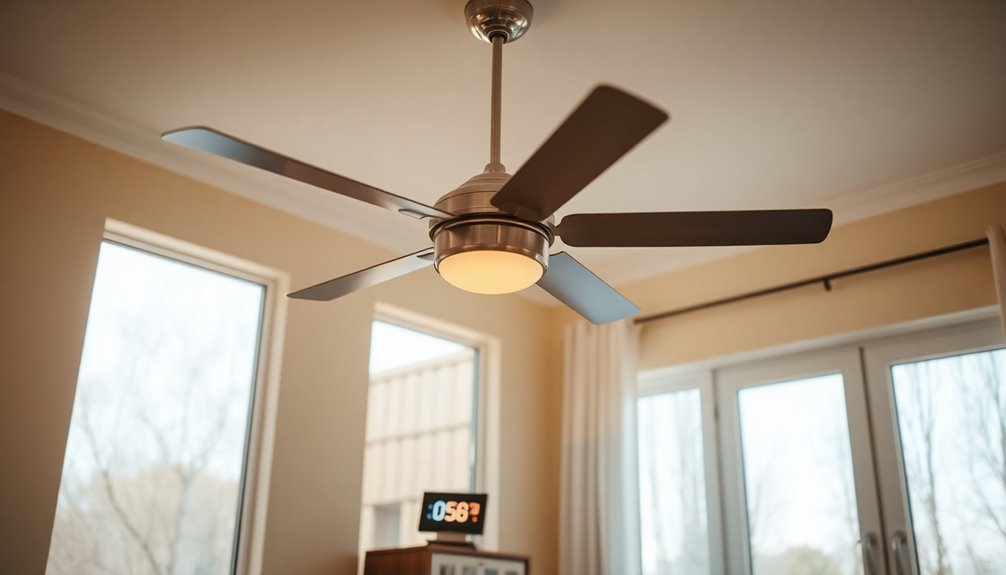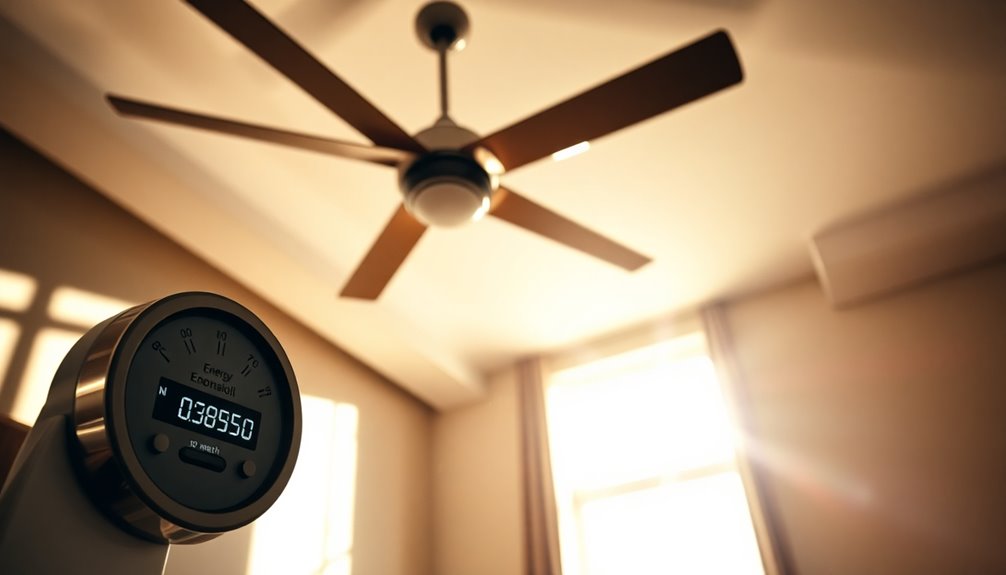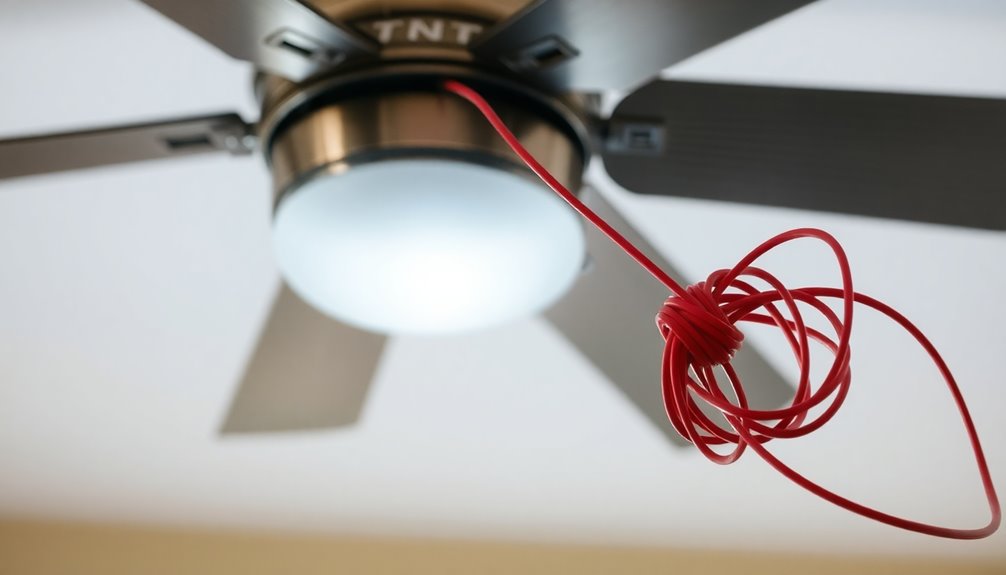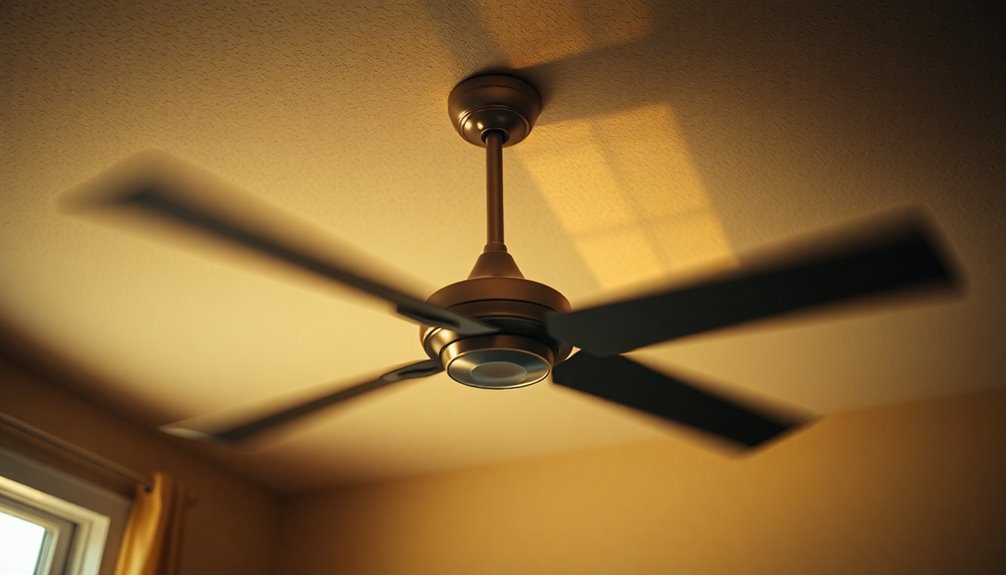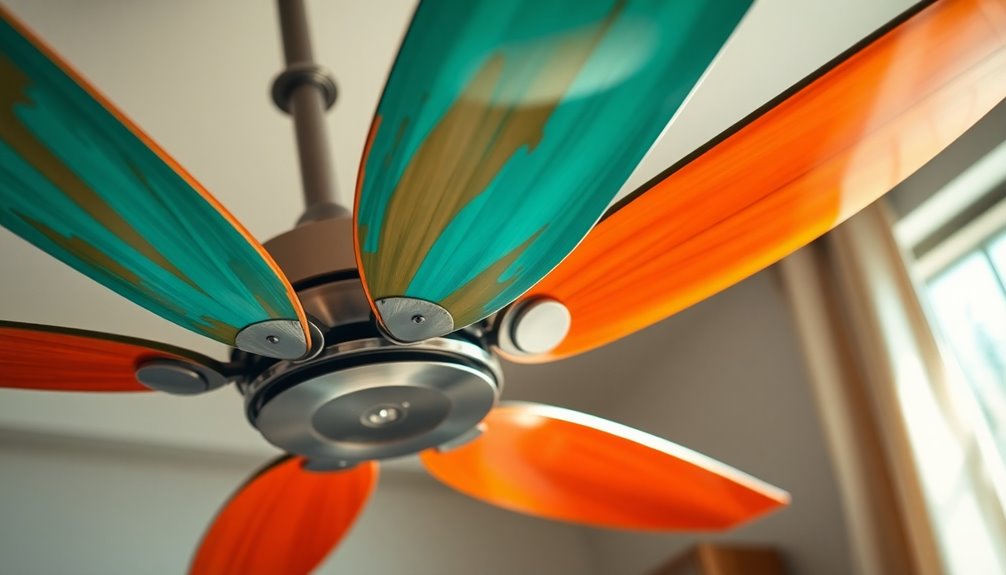A standard ceiling fan usually uses between 50 to 80 watts per hour. If it has lights, that number can jump to 175 to 200 watts. Running a typical fan costs you about $0.09 per hour, which adds up to around $18.25 annually if operated six hours a day. This makes ceiling fans a much cheaper cooling option compared to air conditioners, which can use up to 3,500 watts per hour! Factors like fan size and speed settings can also affect energy usage, which might surprise you. Stick around, and you'll find out more tips to optimize your ceiling fan use!
Key Takeaways
- Standard ceiling fans consume between 50 to 100 watts per hour, with an average 48-inch fan using about 75 watts.
- Ceiling fans with integrated lighting can use 175 to 200 watts per hour.
- Energy-efficient ceiling fans can operate on as low as 15 to 25 watts, making them 60% more efficient than standard models.
- Running a typical 75-watt ceiling fan for an hour costs approximately $0.054 based on average electricity rates.
- Larger fans may consume around 90 watts per hour, while smaller fans generally use about 55 watts.
Ceiling Fan Energy Usage Overview

Understanding how much electricity a ceiling fan uses is essential for managing your energy costs. A standard ceiling fan consumes between 50 to 80 watts per hour when it's running without lights. If your ceiling fan has lights, the electricity usage jumps to about 175 to 200 watts per hour.
On average, a ceiling fan uses around 75 watts, which translates to approximately $0.09 per hour based on typical electricity rates.
If you run your ceiling fan for six hours daily, you can expect an annual energy consumption cost of about $18.25. This makes ceiling fans a cost-effective option for cooling compared to air conditioners, which can consume an astounding 3,500 watts per hour.
By understanding the power your ceiling fan consumes, you can better manage your energy expenses. Using a ceiling fan not only helps you save money but also keeps your home comfortable.
Average Wattage Consumption

When you consider ceiling fans, you'll notice that their power usage can vary quite a bit.
Standard models usually consume between 50 to 80 watts per hour, while energy-efficient options can use just 15 to 25 watts.
Understanding these differences can help you choose a fan that balances performance and efficiency.
Typical Power Usage
Ceiling fans are a popular choice for keeping your space comfortable, but knowing how much electricity they use can help you make informed decisions.
The typical power usage of a ceiling fan can vary greatly based on its design and features. A standard ceiling fan usually consumes between 50 to 80 watts per hour when operating without lights. If your fan has integrated lighting, expect the ceiling fan wattage to increase to around 175 to 200 watts per hour.
On average, a 48-inch ceiling fan consumes approximately 75 watts of electricity per hour, making it a reasonable option for most rooms.
However, if you're looking to save on electricity usage, consider investing in energy-efficient ceiling fans, which can consume as little as 15 to 25 watts. These models greatly lower your power consumption while still providing comfort.
Efficiency Comparisons
In the domain of energy efficiency, ceiling fans stand out as a cost-effective cooling option. Their electricity consumption is considerably lower than many traditional cooling methods.
Let's break down the average wattage consumption of ceiling fans compared to other devices:
- Standard Ceiling Fans: Typically consume between 50 to 80 watts per hour without lights, and 175 to 200 watts with lights.
- Average Ceiling Fan: Consumes around 75 watts, equating to about 0.075 kilowatt-hours (kWh) per hour.
- Energy-Efficient Models: These can operate on just 15 to 25 watts, drastically cutting down on power consumed.
- Air Conditioners: In stark contrast, they can use up to 3,500 watts per hour, making ceiling fans a much more economical choice.
Considering the cost to run a standard ceiling fan for 6 hours is roughly 5 cents, it's clear that ceiling fans are an energy-efficient alternative for cooling.
Cost of Running a Ceiling Fan

Running a ceiling fan is generally an economical choice for keeping your space comfortable. Standard ceiling fans typically consume between 50 to 80 watts per hour when they're operating without lights. If you choose a fan with lights, that average wattage can jump to 175 to 200 watts.
However, energy-efficient ceiling fans, especially those rated by Energy Star, can be up to 60% more efficient than their non-rated counterparts, greatly reducing your electricity costs.
To understand the cost of running a ceiling fan, consider the average electricity rate in the U.S., which is around $0.10 per kilowatt-hour. For instance, a 75-watt ceiling fan running for 6 hours would consume about 0.45 kWh, costing you roughly $0.045.
Over a day, running a standard ceiling fan for 6 hours typically costs about $0.05, or $18.25 annually.
Keep in mind that local electricity rates can vary, so it's important to check your specific rate to calculate the precise cost of running a ceiling fan in your home.
Comparison With Air Conditioning

When you compare ceiling fans to air conditioners, the difference in energy consumption is striking.
A ceiling fan uses only 50 to 80 watts per hour, while an air conditioner can consume up to 3,500 watts.
This drastic difference not only affects your energy bill but also highlights how cost-effective ceiling fans can be for keeping your space cool.
Energy Consumption Comparison
Ceiling fans offer a stark contrast to air conditioning regarding energy consumption. When you consider the power consumption of these two cooling options, it becomes clear why ceiling fans are the more energy-efficient choice.
Here's a quick comparison to highlight the differences:
- Electricity Usage: Standard ceiling fans consume between 50 to 80 watts per hour, while air conditioners can use up to 3,500 watts.
- Cost: Running a ceiling fan for 6 hours costs about $0.054, in stark contrast to air conditioning, which can set you back approximately $1.20 for the same time.
- Annual Expenses: Operating a ceiling fan daily for 6 hours can lead to an annual cost of around $18.25, whereas air conditioning expenses may exceed $400.
- Energy Efficiency: Ceiling fans use about 10% of the electricity of a standard air conditioning unit, making them an excellent option for reducing electricity costs.
Cost Efficiency Analysis
Many homeowners overlook the impressive cost efficiency of ceiling fans compared to air conditioning. When you consider the electricity usage, ceiling fans typically consume between 50 to 80 watts per hour. In stark contrast, air conditioners can use up to 3,500 watts per hour, resulting in substantial differences in power consumption and cost. Running a ceiling fan for 6 hours costs about 5 cents per day, while the same duration with an air conditioner can set you back around $1.20. The annual cost of operating a ceiling fan for 6 hours daily is approximately $18.25, whereas air conditioning under similar conditions can cost you about $438.
By choosing an Energy Star-rated ceiling fan, you can boost your cost efficiency even further, as these models can be up to 60% more efficient than non-rated ones. Additionally, by raising your thermostat settings by 4°F while using a ceiling fan, you'll save energy and considerably reduce your air conditioning costs. Moreover, using energy-efficient technology in cooling solutions can further enhance your savings.
Ultimately, ceiling fans not only provide comfort but also offer a smart, cost-effective cooling solution for your home. High-performance ratings ensure that your ceiling fan operates effectively in various climates and conditions.
Factors Affecting Energy Usage

Energy usage in ceiling fans is influenced by several key factors that can impact your electricity bill. Understanding these factors can help you make informed decisions about your cooling needs.
1. Wattage: Ceiling fans typically range from 50 to 100 watts per hour, depending on their size and model.
Larger fans consume more power; for example, a 52-inch fan may use around 90 watts, while a 36-inch fan might use only 55 watts.
2. Speed Setting: The energy consumption varies considerably with speed settings.
Running your fan on a high setting increases wattage usage, which can lead to higher electricity costs.
3. Integrated Lighting: If your ceiling fan has integrated lighting, be prepared for increased energy usage.
These fans can consume between 175 to 200 watts, adding to your total power consumption.
4. Energy-Efficient Models: Opting for energy-efficient ceiling fans, such as those rated by Energy Star, can reduce power consumption by up to 60% compared to standard models, helping you save on your electricity bill.
Energy Efficient Ceiling Fans

Energy-efficient ceiling fans are designed to use considerably less power than standard models. While typical fans consume between 50 to 80 watts per hour, energy-efficient models can operate on just 15 to 25 watts per hour. This drastic reduction in electricity consumption can help you reduce electricity costs without sacrificing comfort. Additionally, the use of smart technology in some ceiling fans allows for optimized energy usage and remote control, further enhancing efficiency. Furthermore, using energy-efficient systems like ceiling fans can contribute to overall energy savings in your home.
When selecting fan models, consider the size of your room. A properly sized 44-inch fan is ideal for spaces up to 225 square feet, maximizing airflow while minimizing energy usage. Proper sizing ensures efficient air distribution and prevents unnecessary energy waste.
Additionally, regular maintenance and cleaning can enhance your fan's performance, ensuring it operates at peak wattage. Regular maintenance can also enhance efficiency by preventing potential issues that might escalate and require costly repairs.
You can further boost your energy savings by adjusting your thermostat settings upward by 4°F while using your ceiling fan.
Remember, fans cool people, not the air, so this simple adjustment can lead to noteworthy reductions in your electricity consumption.
Calculating Daily Usage

When calculating daily usage for your ceiling fan, you'll want to evaluate the wattage it consumes, which can vary by model.
Understanding the daily cost of operation helps you budget effectively, and determining how often you use it can impact your overall expenses.
Let's break down these factors so you can make informed decisions.
Wattage Variations Explained
How can you accurately determine the daily electricity usage of your ceiling fan? Understanding the wattage variations is essential. Typically, ceiling fans use between 50 to 100 watts per hour, with most averaging around 75 watts for standard models.
Here's how to calculate your fan's daily usage:
- Wattage: Identify the wattage of your ceiling fan. Standard fans usually range from 50 to 100 watts.
- Usage Hours: Note how many hours the fan runs each day. For example, if it's on for 6 hours, you'll need this number for calculations.
- Daily Consumption: Multiply the wattage by the number of hours. For a 75-watt fan running 6 hours, that's 75 x 6 = 450 watts or 0.45 kWh.
- Energy Efficiency: Consider energy-efficient models that consume less, often between 15-25 watts, to save on electricity. Additionally, selecting a ceiling fan with high CFM ratings can enhance airflow while maintaining low power consumption.
Daily Cost Estimation
Estimating the daily cost of running your ceiling fan is straightforward and can help you budget for electricity expenses.
To calculate your daily consumption, start by identifying the wattage of your fan. For instance, if you have a standard 75-watt ceiling fan and you run it for 6 hours, it consumes 0.45 kWh (75 watts x 6 hours ÷ 1000). At an average electricity rate of $0.10 per kWh, that translates to about $0.054 per day.
If you have an energy-efficient ceiling fan, the savings can be even greater. Fans with integrated lights typically use more electricity, ranging from 175 to 200 watts per hour. Consequently, if you're running such a fan for the same duration, your daily costs could rise considerably.
Understanding these figures allows you to anticipate how much your ceiling fan adds to your electricity bill. By regularly using your ceiling fan instead of air conditioning, you could save roughly $18.25 annually, making it a cost-effective choice for cooling your home.
Keep these calculations in mind to manage your expenses effectively.
Usage Impact Assessment
Understanding the daily usage of your ceiling fan is key to evaluating its overall impact on your electricity consumption. By calculating how many hours a day you run it and its power consumption in watts, you can better manage your energy costs.
Here's a simple breakdown:
- Determine the wattage: Standard ceiling fans typically use between 50 to 80 watts. If yours consumes 75 watts, that's your baseline.
- Calculate daily usage: If you run your fan for 6 hours a day, multiply 75 watts by 6 hours, giving you 450 watt-hours or 0.45 kWh.
- Estimate the cost: At an average rate of $0.12 per kWh, operating your fan for 6 hours a day costs about $0.054.
- Consider extras: If your fan has lights, its electricity usage jumps to 175-200 watts per hour, greatly impacting your ceiling fans' power consumption.
Tips for Reducing Costs

To save money on your electricity bill, consider a few simple strategies for using your ceiling fan effectively.
First, remember that ceiling fans don't cool the air; they create a wind-chill effect. So, turn off the fan when you leave a room to reduce costs. Running a standard ceiling fan typically consumes between 50 to 80 watts per hour, costing you about 5 cents daily if used for six hours.
Opt for Energy Star-rated ceiling fans, as they're 60% more energy-efficient than non-rated models, leading to lower electricity consumption. You can also adjust your thermostat settings upward by 4°F while using the ceiling fan. This combination allows your cooling system to work less, further reducing your air conditioning costs.
Regular maintenance is essential, too. Cleaning your fan blades and ensuring it operates smoothly can enhance its performance and energy efficiency, ensuring lower energy usage over time.
Fan Size and Efficiency

Choosing the right ceiling fan size greatly impacts its efficiency and your energy consumption.
Selecting an appropriate fan size guarantees you maximize energy savings while minimizing power consumption. Here's what you need to take into account:
- Fan Size Matters: A 44-inch fan is ideal for spaces up to 225 square feet, while a 52-inch fan suits rooms up to 400 square feet.
- Watts Per Hour: A standard 48-inch ceiling fan typically uses around 75 watts per hour, but larger fans, like the 52-inch model, can consume about 90 watts.
- Efficiency Ratings: Energy Star-rated ceiling fans can be 60% more efficient than non-rated models. This efficiency translates to significant energy savings over time.
- Avoid Over-Sizing: Installing an overly large fan in a small room leads to unnecessary energy consumption and discomfort from excessive airflow.
Understanding Local Electricity Rates

Local electricity rates can greatly impact your energy costs when running a ceiling fan. In the U.S., the average rate is about $0.10 per kilowatt-hour (kWh), but this can vary markedly depending on your region.
To get the most accurate and up-to-date information, it's important to check with your local utility providers, as rates fluctuate based on energy policies and market conditions.
Understanding your local electricity rate helps you budget effectively and allows for better cost estimation when calculating the daily or monthly expenses associated with operating a ceiling fan.
If you find that your area offers lower rates during off-peak hours, consider running your fan during these times to save on electricity costs.
This knowledge is vital, especially when weighing the economic benefits of ceiling fans against higher-consuming appliances like air conditioners.
By comparing usage and costs, you can make informed decisions about your energy consumption.
Frequently Asked Questions
How Much Does It Cost to Run a Ceiling Fan 24 Hours a Day?
Running a ceiling fan 24 hours a day typically costs you about $8.64 to $14.40 a month, depending on the fan's wattage and your local electricity rates.
If you keep it on all the time, you'll notice a slight increase in your electricity bill.
However, compared to air conditioning, it's a much cheaper alternative for cooling your space.
Just remember to turn it off when you don't need it!
Do Ceiling Fans Use a Lot of Electricity?
Did you know that running a ceiling fan for six hours only costs you about 5 cents? That's right; ceiling fans don't use a lot of electricity at all!
In fact, standard models typically consume between 50 to 80 watts per hour.
Even with lights, they're far more economical than air conditioning, making them a smart choice for keeping cool without breaking the bank.
You'll save money while staying comfortable!
How Much Electricity Does a Ceiling Fan Use in 1 Hour?
When you run a standard ceiling fan for one hour, it typically consumes between 50 to 80 watts.
For instance, if you use a 75-watt fan, you'll be using about 0.075 kilowatt-hours (kWh) of electricity.
At an average cost of $0.10 per kWh, that's only about $0.0075 for an hour's use.
Compared to air conditioners, ceiling fans are a much more energy-efficient choice for cooling your space.
Is It Expensive to Leave a Fan on All Day?
Leaving a fan on all day isn't as expensive as you might think.
It's cost-effective, it cools your space, and it saves energy compared to air conditioning.
You'll spend around $3.60 to $5.70 monthly, depending on usage and rates.
When you consider the potential savings on your electricity bill, using a ceiling fan regularly can be a smart choice.
Conclusion
To summarize, knowing how much electricity a ceiling fan uses can help you save money and energy. Remember, "a penny saved is a penny earned." By choosing the right size and being mindful of your fan's usage, you can enjoy a comfortable environment without breaking the bank. So next time you reach for the remote, think about how a ceiling fan might just be the efficient choice you're looking for!
